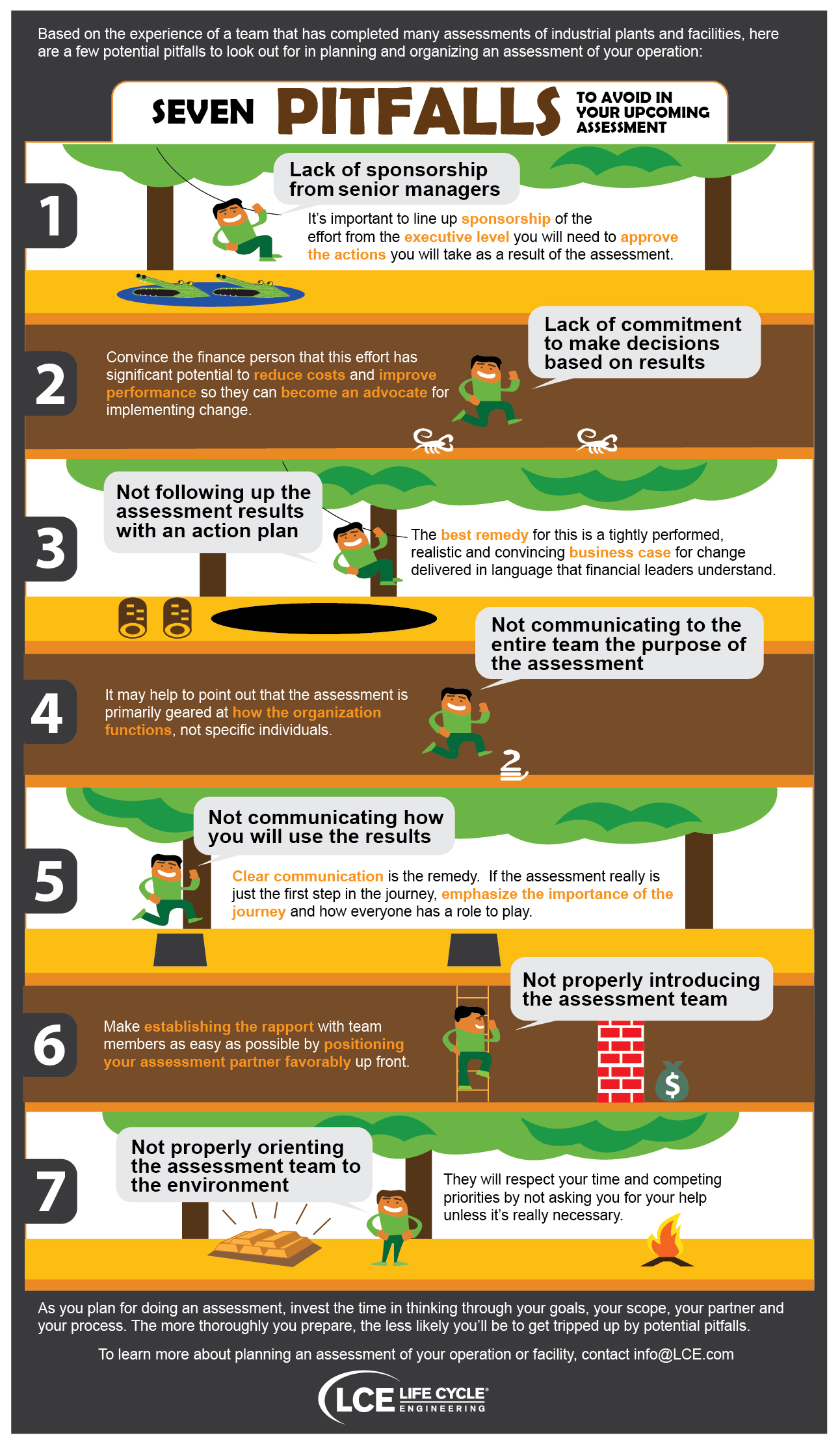Seven Pitfalls to Avoid in Your Upcoming Assessment
By Catherine Marshall, Director, Life Cycle Engineering
The first step most organizations take in their continuous improvement journey is to undertake an assessment that will capture the current state of their operations and compare it to best practices. Based on the experience of a team that has completed many assessments of industrial plants and facilities, here are a few potential pitfalls to look out for in planning and organizing an assessment of your operation:
- Lack of sponsorship from senior managers: Because an assessment is the first step for planning a continuous improvement initiative, it’s important to line up sponsorship of the effort from the executive level you will need to approve the actions you will take as a result of the assessment. You want senior leaders to understand the importance of closing the gaps between current and future-state performance so that you will be able to get the funding required to close the gaps and yield the performance gains.
- Lack of commitment to make decisions based on results: It may be that you can gain approval to do an assessment but you can’t get commitment to an implementation plan until the assessment is complete and the scope of needed change is clearly understood. That’s a reasonable expectation. It’s hard for anyone to approve a concept without knowing the scope. This makes it all the more important to make sure your assessment partner gets the data they need to make a financial assessment of current state and the potential gains from a step-change in performance. Convince the finance person that this effort has significant potential to reduce costs and improve performance so they can become an advocate for implementing change.
- Not following up the assessment results with an action plan: This pitfall usually happens not because the sponsor of the assessment project didn’t want to move forward, but because he could not get the required approval for the upfront investment required to achieve a step-change in operating performance. The best remedy for this is a tightly performed, realistic and convincing business case for change delivered in language that financial leaders understand. Figuring out where the quick-wins are – the high-priority fixes to performance-limiting problems – can help you demonstrate that your implementation plan will produce significant, measurable ROI.
- Not communicating to the entire team the purpose of the assessment: Let’s face it – being assessed makes even the highest-performing people nervous. It may help to point out that performance is largely determined by the processes and procedures we have in place (and whether they are followed), so the assessment is primarily geared at how the organization functions, not specific individuals. Be clear about why an assessment is needed and that it points to positive opportunities to improve, be more competitive and improve the working environment.
- Not communicating how you will use the results: A natural fear is to expect that an assessment will result in eliminating costs, often translated as eliminating jobs. If you don’t communicate clearly how the results of the assessment will be used, people will fear the worst and it may impact the quality of feedback that assessors collect. Again, clear communication is the remedy. If the goal of the assessment is to figure out the gaps between current practices and best practices and then figure out how to fill the gaps and improve, that’s a very different message than “we’re going to audit how we do things around here.” If the assessment really is just the first step in the journey, emphasize the importance of the journey and how everyone has a role to play.
- Not properly introducing the assessment team: If you’ve done a good job of selecting the partner who will complete the assessment they should be experienced at establishing good rapport with the team members they interview. But make establishing the rapport as easy as possible by positioning them favorably up front. Get to know them ahead of time so that you can introduce them knowledgeably.
- Not properly orienting the assessment team to the environment: This is the flip side of introducing the assessment team to your workplace. Provide the assessment team with as much information as you can and as quickly as you can. They will respect your time and competing priorities by not asking you for your help unless it’s really necessary.
Assessments are an indispensable part of planning a continuous improvement journey. Every journey is a little different and therefore your assessment requirements are going to depend on your organization’s strategy, goals and objectives. As you plan for doing an assessment, invest the time in thinking through your goals, your scope, your partner and your process. The more thoroughly you prepare, the less likely you’ll be to get tripped up by potential pitfalls.
A director at Life Cycle Engineering, Catherine Marshall helps people and organizations discover solutions that improve performance. She can be reached at cmarshall@LCE.com.
© Life Cycle Engineering

